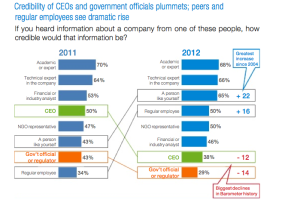There is an old African proverb that says it takes a village to raise a child. The idea behind this proverb is that child upbringing is a collaborative, communal effort. The responsibility rests not only upon the immediate family, but also upon extended family, friends, and even neighbors. This approach to child rearing emphasizes core values of family relationships, sharing, hospitality, and most importantly, concern for others.
One can draw a comparison to the messages in Michael Brito’s book Smart Business, Social Business. Brito maintains the idea that for a business to be successful in social media, the culture of the company has to be one that reflects transparency and collaboration. Long gone are the days of a company spokesperson projecting one-way messages. Brito argues that a better strategy is to involve the company as a whole, where every employee, in every department, from sales and marketing to customer service are empowered to engage on social media channels on behalf of the brand.
That’s great in theory, but how does a company change the way it does business to be transparent and collaborative? Brito suggests that this cultural shift needs to start from the top to remove traditional silos that stifle innovation, collaboration, and communication on social media platforms. Companies must also effectively communicate internally to have effective external conversations. The entire company must have a thorough understanding of the mission, goals, strategy, and tactics to communicate clearly and avoid confusion. Ultimately this will lead to a stronger company that more effectively meets the needs of the social consumer.
Furthermore, Brito asserts that humans relate to humans, as such it’s important to build personal relationships through social conversations with real employees involving two-way dialog. Edelman, a leading public relations firm, suggests that empowering employees to be ambassadors of the brand and engaging customers through social media will lead to improved credibility and trust. According to the Edelman Trust Barometer, an annual global trust and credibility survey, consumers trust employees and peers more than technical experts, corporate representatives, or government officials. As a result, more trust is placed on social media channels than corporate communications, news articles, or advertisements.
Like any conversation, dialog through social media requires active listening. This is a crucial step that provides insight into what the community, advocates, influencers, consumers, and even advisories are saying. Brito outlines several social listening and social relationship management software that companies can utilize to monitor and manage conversations on blogs, forums, Twitter, and Facebook.
Examples of Listening and Relationship Management Software:
- Radian 6
- Lithium
- Meltwater Buzz
- Sprinklr
- Awareness
- Syncapse Platform
- Amplicate
- Social Mention
- Twitter Sentiment
- Google Alerts
 Conversations also require responsive, relevant dialog. The same holds true in the social media space. Companies need to follow through with a plan of action and strategy to respond, collaborate, interact, and engage to address what is learned through this listening process. Utilizing social relationship management applications, like the ones mentioned above, enables communicators to share relevant information from across the corporation. Relevant content adds value to the conversation, builds trust, and increases reach for brands. What is relevant content? It is any content that delivers valuable information, free of sales propaganda, with the end goal of being trusted and believable.
Conversations also require responsive, relevant dialog. The same holds true in the social media space. Companies need to follow through with a plan of action and strategy to respond, collaborate, interact, and engage to address what is learned through this listening process. Utilizing social relationship management applications, like the ones mentioned above, enables communicators to share relevant information from across the corporation. Relevant content adds value to the conversation, builds trust, and increases reach for brands. What is relevant content? It is any content that delivers valuable information, free of sales propaganda, with the end goal of being trusted and believable.
The idea of letting employees loose to engage on social media may scare many corporations. To maximize the effectiveness of social media engagement, and to protect both employees and the company from potential public embarrassment, brands must develop social media policies and guidance. This guidance shouldn’t be a scare tactic but rather a tool to communicate the business code of conduct and the rules of engagement. To gain measured success all outbound conversations must communicate the same message.
So how does a brand know if their efforts to listen, manage, and engage are working? It’s critical that they establish measurement practices that align with their business objectives. These objectives will likely fall somewhere in the purchase funnel, which includes awareness, consideration or preference, purchase, and advocacy. If the brand’s objective is to simply raise awareness, then they would measure reach. In this case, they may choose to track Facebook messages, retweets, or comments on corporate blogs. If the brand is concerned about preference, it may track engagement, such as Facebook fan growth, Twitter follower growth, or time spent on a web site. There are a variety of ways to measure the effectiveness of the social media plan, brands need to choose a strategy that makes sense for them and is maintainable.
Brito’s guidance can inform my client’s strategy to empower employees throughout the organization to advocate on behalf of the company. Like many non-profit organizations, Patuxent Habitat for Humanity is stretched thin when it comes to manpower. However, creating a collaborative environment where the entire organization all communicate relevant information on social media platforms will build credibility, improve reach, and increase organic search results.
Additionally, utilizing listening software such as Radien 6, RowFeeder, or Export.ly, my client will be able to conduct a conversation audit to better understand conversations happening around the organization, and where these conversations are taking place. Through active listening they will be able to monitor share of voice and sentiment as well as respond accordingly. This audit will also help to identify advocates who can influence their micro communities to support my client. Lastly, my client will be able to understand conversations that are happening around competitors such as Christmas in April, Good Will, and The Salvation Army.
Brito’s book does an excellent job in demonstrating the variety of tools available to conduct a social strategy. In one such example, Britto provides clear guidance and case studies for establishing training and governance models. This will inform my client’s strategy by establishing standards for employees to use while engaging on social platforms on behalf of the organization.
Image source – Edelman and Microsoft


